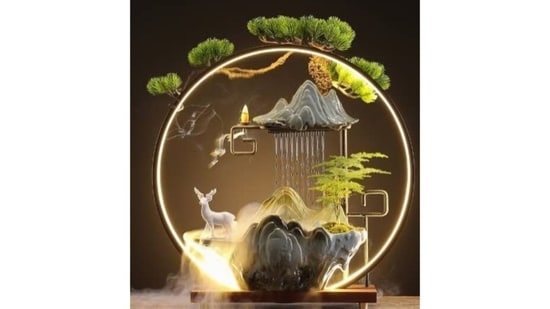From minimalist to eclectic, Zen-inspired decor effortlessly complements a diverse range of design sensibilities, creating unexpected yet captivating interiors.
In the ever-evolving landscape of home decor, the fusion of different design styles has emerged as a captivating trend, offering a fresh perspective on interior aesthetics and one such intriguing collaboration is the integration of Zen principles with various design styles, resulting in harmonious and serene living spaces that transcend traditional boundaries. From minimalist to eclectic, Zen-inspired decor effortlessly complements a diverse range of design sensibilities, creating unexpected yet captivating interiors.

In an interview with HT Lifestyle, Manas Jaiswal, Founder of Ur Soul Mantra, suggested some unexpected Zen collaborations with different home decor and interior design styles
- Minimalist Zen Fusion: In the realm of minimalist design, simplicity reigns supreme. By incorporating Zen elements such as clean lines, natural materials, and a neutral colour palette, minimalist spaces evoke a sense of calm and tranquility. A Zen-inspired minimalist interior emphasizes functionality and mindfulness, with uncluttered spaces that promote clarity of mind and purposeful living. For example, a contemporary Indian apartment adorned with simple wooden furniture, muted earth tones, and potted plants embodies the essence of Zen minimalism, creating a serene retreat amidst the bustling city life.
- Bohemian Zen Fusion: On the opposite end of the spectrum lies the bohemian style, characterized by its eclectic and free-spirited aesthetic. When infused with Zen principles, bohemian decor embraces a more serene and balanced approach. Think vibrant textiles juxtaposed with natural textures, lush greenery amidst colorful accents, and curated collections that reflect a sense of mindfulness and connection to nature. An Indian bohemian-inspired living room featuring vibrant embroidered textiles, intricately carved wooden furniture, and a corner dedicated to meditation and yoga exemplifies the fusion of bohemian flair with Zen serenity.
- Scandinavian Zen Fusion: Scandinavian design celebrates simplicity, functionality, and the beauty of natural elements. When combined with Zen influences, Scandinavian interiors exude a sense of calm and warmth. Light-filled spaces adorned with natural wood accents, cozy textiles, and minimalist furnishings create a serene sanctuary that promotes relaxation and well-being. An Indian-inspired Scandinavian bedroom featuring whitewashed walls, wooden accents, and soft textiles in earthy tones offers a tranquil retreat from the chaos of everyday life, embracing the Zen philosophy of simplicity and mindfulness.
- Industrial Zen Fusion: The industrial style is characterized by its raw and rugged aesthetic, often associated with urban loft living. However, when infused with Zen principles, industrial spaces take on a softer and more contemplative tone. Exposed brick walls, weathered metal accents, and reclaimed wood furniture are softened by the addition of natural elements and a subdued color palette, creating an industrial-inspired oasis of tranquility.
Manas Jaiswal shared, “The essence of Zen lies in its ability to cultivate mindfulness, balance, and harmony in all aspects of life, including home decor. By embracing unexpected collaborations with different design styles, we can create living spaces that not only reflect our personal tastes but also nourish the mind, body, and soul. Whether minimalist, bohemian, Scandinavian, or industrial, the integration of Zen principles adds a layer of depth and serenity to our homes, inviting us to live with intention and presence in every moment.”
Bringing his expertise to the same, Sanjay Pareek, Co-Founder and Director at BeyondnMore, revealed, “Zen decor embodies a philosophy deeply rooted in simplicity, authenticity, and harmony with one’s surroundings. Its profound insights into the art of creating serene living spaces emphasize the balance between function and form, mirroring the delicate equilibrium sought in life.”
He explained, “At the core of Zen-inspired design lies minimalism, advocating the “less is more” approach. This philosophy encourages decluttering and eliminating excess to create tranquil environments where each room can breathe freely. Minimal furnishings and subtle decor pieces are preferred, allowing space for contemplation and calm. Natural materials play a pivotal role in Zen decor, with a preference for wood, stone, and natural fabrics. These elements not only establish a connection to the earth but also promote sustainability, aligning with Zen principles of simplicity and authenticity.” Sanjay Pareek highlighted:
- Several styles reflect Zen principles, including Wabi-Sabi, which celebrates imperfection and the beauty of natural aging. Japandi, a fusion of Japanese minimalism and Scandinavian design, combines clean lines with warm, natural textures to create harmonious spaces.
- Contemporary, minimalist and industrial designs also resonate with Zen principles by prioritizing simplicity, functionality, and uncluttered aesthetics. Each design element serves a practical function, contributing to the overall tranquility and mindfulness of the space.
- Zen-inspired interiors prioritize functionality over fleeting trends, ensuring that every aspect of the design serves a purpose while maintaining a natural aesthetic. It transcends mere decoration to become a harmonious extension of one’s environment and values, promoting well-being and mindfulness in everyday life.
Catch your daily dose of Fashion, Taylor Swift, Health, Festivals, Travel, Relationship, Recipe and all the other Latest Lifestyle News on Hindustan Times Website and APPs.
- Home Decor
- Home
- House
- Style
- Trend
- Trends
- Interior Decor
- Interior Design
- Decor
- Design
- Designer
- Artist
- Living Space





